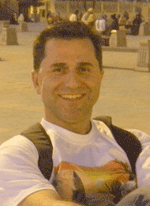Member Spotlight Cemal Unal
Cemal Unal
I can remember certain events very well. In particular, I remember being a high-school graduate in Ankara, Turkey. It was 1982 and I had to take a nationwide exam to enter a university. The score from this exam would determine which university I went to and what I studied. I wanted to be an engineer, so I listed the top universities with engineering and statistics degrees. Well, you can guess the rest.
I studied statistics for four years at Middle East Technical University (METU). This university has a strong undergraduate statistics program. At the beginning, with all the math and p-values, I was lost. As I studied more and became exposed to real-life problems involving statistical methods, however, I started to like statistics. I would say it is very important to help students understand the value of what they are studying during the early years of their education. This keeps them motivated and optimistic for the future.
After earning my undergraduate degree in 1987, I decided to study more statistics (by now, I was loving it) and applied for the master’s program. In 1990, I earned my master’s degree from METU and won a scholarship to study in the United States. For the love of statistics, I packed my stuff and moved to North Carolina State University—where there was, and still is, a strong statistics program for technology and clinical drug development.
While earning my PhD, I was lucky to have internship opportunities with a variety of companies. I worked for a company making cereal boxes, for another company making computer chips, and finally for a pharmaceutical company. My excitement about the use of statistics in real life reached its peak when I started working for GlaxoWellcome as a statistician/statistical programmer.
As a statistical programmer, I used my skills to do data analysis and statistical modeling while learning the terminology and process for drug development. The more I learned about drug development, the more I appreciated the use of statistics in this industry. For the first time, I thought I did the right thing by studying statistics.
While I worked in one therapeutic area at GlaxoWellcome, I had the opportunity to work in a variety of therapeutic areas in a contract research organization (CRO), for which I worked for about eight years as a statistician. In the CRO environment, I learned how to work with other people and supervise statisticians. Even though I had management responsibilities, I always considered myself a statistical scientist and enjoyed being a statistician more than a manager. One must be careful when making a decision about whether to stay on the technical track (i.e., hands-on statistician) or move to the management track and pick the one he or she would enjoy the most.
After leaving the CRO, I went to work in the oncology area at Merck. What a rewarding position. I still remember the letters we got from people who participated in our clinical trials. It was such an honor to be part of a team developing drugs for cancer and giving hope to people. Each therapeutic field has its own way of designing, conducting, and analyzing data from clinical trials. From study design to data collection, oncology was the most challenging and the most fun for me.
As statisticians, we should learn how to work with and educate ourselves about relevant topics in other disciplines. While I worked in the pharmaceutical industry, I noticed I worked with medical experts more than other departments. For a statistician to be successful in the pharmaceutical industry, he or she needs to understand the therapeutic area and disease under study, read the literature, and consult with other statisticians.
I strongly suggest attending workshops and seminars on disciplines of interest, as well as statistical subjects. For example, designing a clinical study protocol requires not only a strong statistical background but an understanding of the disease to be studied. Statisticians should ask experts questions in their respective fields so they can come up with the right statistical considerations and statistical methods for data analysis. After reading and working as a statistician in cancer drug development, I thought I could put medical and statistical minds together and find a cure.
Currently, I am the vice president of biostatistics and data management at Pozen Inc. I live in Raleigh, North Carolina, and have been married to a statistician for almost 20 years. I have two wonderful kids. Traveling, soccer, biking, drawing, tennis, and exercising are among my hobbies. I believe in giving back to society and organize and participate in charity events.



















thank you for this writing.